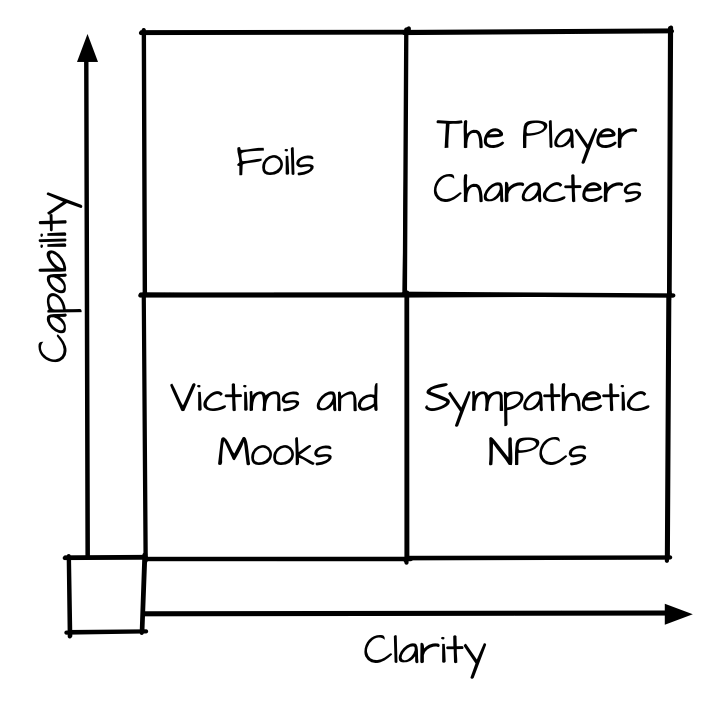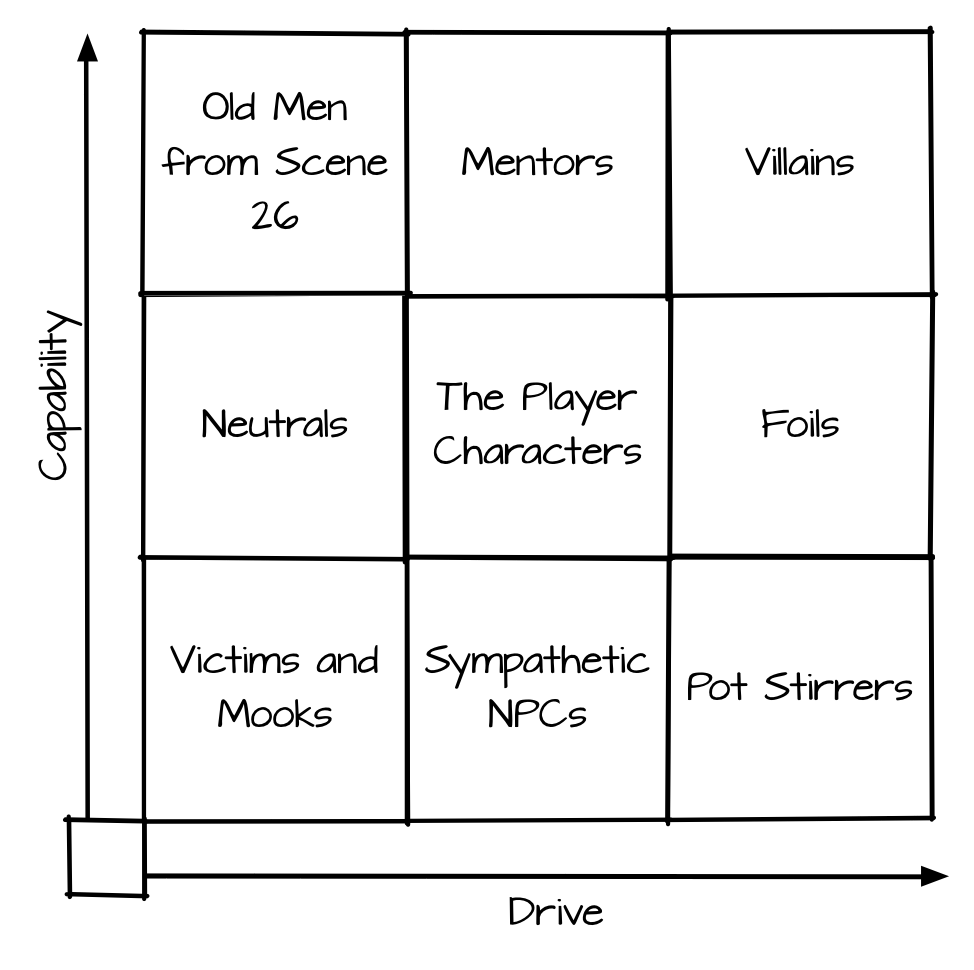I was watching some clips of Leverage, as I am sometimes wont to do, and I was particular taken by a sequence of supporting characters.
The thing about Leverage is that the crew are very capable, but they also have a code, something that makes them good guys. I’m calling this clarity, but feel free to pick your own word. It’s important that there are two axes, because they provide a useful comparison to the characters around them.
That is to say, if there is someone important to the show who is not a member of the crew, they are lacking in one \of those two categories. Characters who have capability but not clarity tend to be enemies or foils (Sterling, Chaos and so on). Characters who have clarity but not capability tend to be allies and supporting characters (the FBI agents, Maggie, Jack Hurley). Characters lacking in both tend to be mooks or victims, and sometimes marks. It’s all pretty easy to illustrate in a grid.
Marks, notably, fall outside of this arrangement because their role is very different. They are often more and less capable than the crew, and may have both more and less clarity. I’m ok with that for Leverage.
Anyway, I’m intrigued by the grid because I want to remember to use it in my own games, specifically to make sure that I have names in every box. It’s easy to remember the foils because they’re so much fun, but it’s worth the effort to remember the sympathetic NPCs. If your heroes have clarity regarding who they are, nothing tests that like someone else trying to live up to the same rules and failing.
But it’s also kind of Leverage specific, since it’s a game where it’s appropriate that the PCs are “up and to the right”. That’s far from common, so I tweaked the model a bit for more traditional games.

Notably I replaces “clarity” with “drive”. This partly moves away from the moral component from leverage, but it also allowed me to move the foils to the right. 🙂 In this case, drive equates to the strength and direction of a character’s agenda.
The lower left is still largely the same, except the foils have been replaced by neutrals – characters who could act, but choose not to. On paper, these should be the most boring of characters, but in small doses they tend to be quite compelling.
Above them is the Old Man From Scene 26, which is the stand in for overpowered NPCs with no reason to be there. They tend to not contribute much to a game, but some setting shave a role for powerful observers or the equivalent. They may be more prize than participant.
To the right we have the mentors – the folks who are similar to the PCs but more capable. As with the Old Man From Scene 26, these can be a problem, and it’s best to either remove them from the board early, occupy them, or make them a source of trouble in their own right (in the sprit of the elders of Amber).
I put villains in the upper right, which may seem weird, especially since it’s so close to the PCs and the mentors, but consider: what makes a villain interesting is that they are at odds with whatever the characters want, and they cannot easily be turned from that path. Without those two characteristics, the villain is merely a challenge.
Foils re-emerge on the far right – they are as capable as the PCs, but their motives take them elsewhere.
The lower right is the category I’m east sure of – NPCs with little capability but a lot of drive. That is to say – plot hooks. And that’s great as far as it goes, but I’m not sure what I’d do with an NPC who lives in that space.
As with the Leverage grid, the utility of a grid like this is to be able to drop your NPC names and see if any gaps reveal themselves. It’s a simple trick, but maybe useful.
interesting, I’m going to show this to my GM tonight. As for the bottom far right, that looks like Quest Givers. All the desire for getting the thing done, none of the ability. This might even cover kings etc who may seem to be capable (send in the army!) but can’t for some reason (politics, plausible deniability etc.)
Nice! That is a much better way to put it.
Thank you! Bookmarked, as I’m hopefully about to start writing a new campaign with a new group and a currently-undecided system. Deep ends are the best.
Perhaps the upper left box is Sleeping Dragons. Left alone, they add color and history to the world. But if the players choose to interact with them (unlikely right?) they could move rightward on the grid. Best case, they become Mentors, but they could just as well move all the way over to Villains. Or they say or do something enigmatic (with consequences for the players and/or the world) and then go back to sleep.
Good point, low drive characters could basically be considered to be terrain.
In general this seems to imply reactive-hero style adventurers; everyone who you want them to be involved with is either on the same drive as them or higher.
That means that whereas the leverage one combines moral clarity with “understanding their perspective”, internality etc. this one probably associates higher drive with hiddenness; neutral npcs probably have defined opinions that are just not particularly volatile, same for mooks (“they follow x unquestioningly/until it’s more than they are paid/unless they loose their fear of them”).
In contrast, people with higher drive are people you want the players to be vaguely curious about, or otherwise not know where they are coming from, this helps the GM have the flexibility to keep coming up with new stuff, and means investigation and reveals are possible. As a flip side of this, they need to be loud in some way, drawing attention and making it obvious that they are where the action is.
Another interesting idea based on that; you want players to feel like npcs and mentor characters are about as complex or mercurial as they are. They probably won’t be, as the player has all that time to focus on a single character, whereas you are doing many, but it makes sense to pace your npc development off of the characters, if your sympathetic npcs start getting more complicated, then you probably need to make sure that they are causing problems that players can be involved in. If your neutral npcs start getting more complicated, then maybe you need to either reduce their power level or do whatever fix applies to mentors, or bump them the whole other way and turn them into foils.
The mentor/villain line is probably another one to look at; if your mentor characters start getting too complicated, you might need to swap out some of the restrictions on them in return for obvious opposition potential/moral breakdown, signalling their jump into villain territory. Not all the restrictions though, I think probably any npc more powerful than the PCs, particularly collectively, needs something to absorb them and keep them from overwhelming the PCs ability to plan or explore.